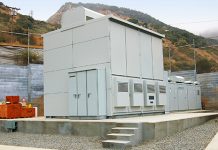John Petersen
I frequently observe that market valuations in the energy storage sector have been wildly distorted by electric vehicle hype that has nothing to do with business fundamentals. Last February I wrote an article that compared Exide Technologies with Ener1, but obviously didn’t quite get to the meat of the matter. Since both companies reported earnings on November 4th, this seems like an opportune time to be more direct in the comparison and present a brief primer on valuations in the energy storage sector.
Since a lot of investors never get beyond stock price movements, the first graph presents a simple price performance comparison of the two companies over the last year.

The second graph comes from my quarterly tracking data and compares the relative market capitalizations of the two companies since September 2009. For novices, market capitalization is calculated by multiplying the total number of shares outstanding by the price per share, which serves as a quick estimate of total stockholder value.

The following table compares the balance sheet fundamentals of the two companies, their income statement performance over the last twelve months, and some important per share valuation metrics. The figures shown for Ener1 give pro-forma effect to an October 1st transaction where the Ener1 Group bought 6.7 million Ener1 shares for $23.7 million in cash and an October 25th transaction where Rockport Capital Partners exchanged 10.2 million shares of Series B Preferred stock in Th!nk Holdings for 4.3 million Ener1 shares.

I understand that Ener1 (HEV) is developing a way-cool lithium-ion battery technology and Exide (XIDE) is so yesterday with its stodgy lead-acid batteries, but let’s get real here. Even if Ener1’s plant was fully funded and operational, and it could sell 60,000 EV battery packs per year at $1,000 per kWh, its revenues wouldn’t be half of Exide’s. If you believe the happy talk about collapsing lithium-ion battery prices, the expectation is more like a quarter of the revenue potential. Since falling prices have a nasty tendency to squeeze operating profits, I don’t see any chance that Ener1’s bottom line income will be anywhere near Exide’s over the next five years.
It’s no secret that I see far more downside risk than upside potential in the plug-in vehicle market, which will supposedly be one of Ener1’s strong suits. It’s also no secret that I see huge upside potential and very little downside risk in batteries for automotive stop-start systems, which will almost certainly be a strong suit for Exide given its relationship with Axion Power International (AXPW.OB). When presented with a choice between betting on a weak business model or a strong business model, I’ll take the strong business model every time.
Investing is a cruel dollars and cents business and the market value of a share of stock is supposed to represent the risk adjusted discounted present value of anticipated future returns. Even if you assume that Ener1 will be smashingly successful, it’s risk adjusted discounted present value can’t hold a candle to Exide’s. The dynamic may change in the future, but for now there is simply no comparison if your goal is to grow an investment portfolio.
Next week I’ll go through the same drill with A123 Systems (AONE) and Enersys (ENS).
Disclosure: Author is a former director of Axion Power International (AXPW.OB) and holds a substantial long position in its common stock.









How are you deciding on each pair of battery companies for side-by-side comparisons? In other words, why didn’t you compare AONE to XIDE and HEV to ENS instead?
It’s actually a bit arbitrary. Exide and Ener1 both reported earnings this week and are the second most valuable companies in their sub-sectors. A123 and Enersys both report earnings next week and are the most valuable companies in their sub-sectors.